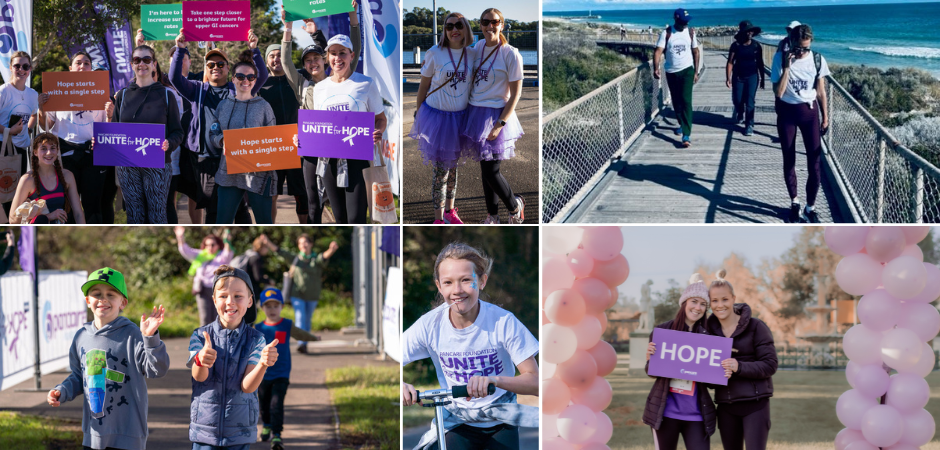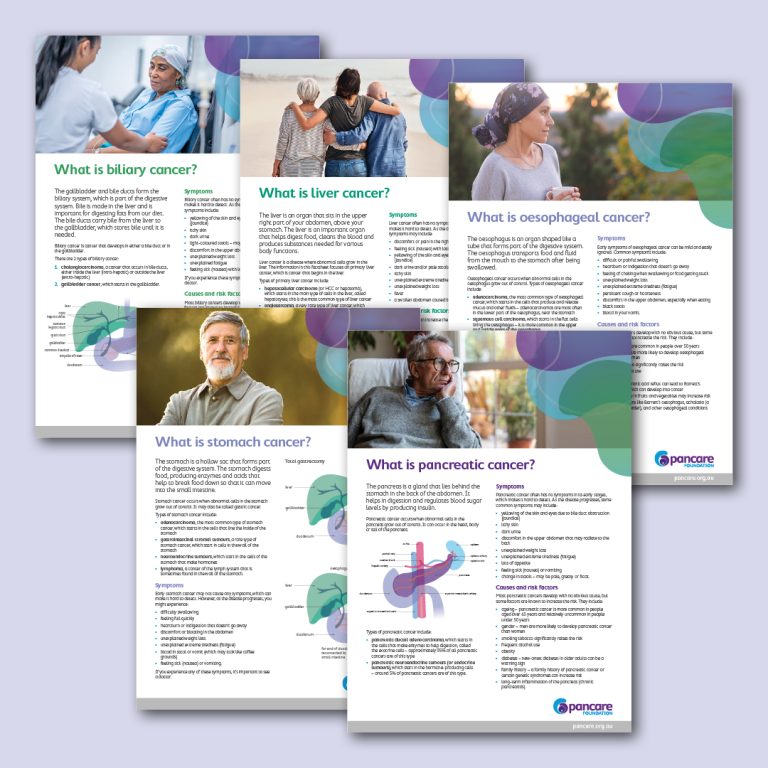Treatment options for stomach cancer
Treatment for stomach cancer depends on the size, location, and stage of the tumour. You should be fully informed and involved in decisions about your treatment options.
On this page:
> Surgery
> Interventions for unresectable cancer
> Chemotherapy
> Radiation therapy
> Clinical trials
> Being referred to a specialist centre
> Your treatment team
Your treatment will depend upon the size, location, and stage of the tumour, as well as your general health and fitness. The choice of treatments will be discussed with you and your preferences will be considered. Your treatment will be discussed by a multidisciplinary team (MDT), which means that experts in different areas of cancer treatment (e.g. surgeons, gastroenterologists, radiologists, oncologists and nurses) come together to share their expertise in order to provide the best patient care.
When treating stomach cancer, surgery may be an option, usually involving removal of tumours, portions of the stomach and neighbouring lymph nodes. Depending on the stage of the tumour, similar results can be achieved either as an open operation or keyhole surgery. Frequently, treatment of stomach cancer involves a combination of chemotherapy and surgery.
Surgery
Once the diagnosis is made, surgery to remove the cancer where possible is the best treatment option in the majority of cases. The aim of surgery may be to remove the cancer, part or all the stomach and some nearby lymph nodes, depending on the type and stage of stomach cancer.
The type of surgery usually depends on what part of the stomach the cancer is in and how much cancer is in the surrounding tissue. Different kinds of surgery can be used to treat stomach cancer:
Endoscopic mucosal resection and endoscopic submucosal resection can be used to treat only some very early-stage cancers in which the chance of spread to the lymph nodes is very low. In an endoscopic resection, the surgeon passes an endoscope (a long, flexible tube with a small video camera on the end) down the throat and into the stomach. Surgical tools can be passed through the endoscope to remove the tumour and part of the normal stomach wall around it.
This operation is when part of the stomach is removed, sometimes along with part of the oesophagus or the first part of the small intestine (the duodenum). The remaining section of stomach is then reattached. Some of the omentum (an apron-like layer of fatty tissue that covers the stomach and intestines) is removed as well, along with nearby lymph nodes, and possibly the spleen and parts of other nearby organs.
Eating is much easier after surgery if only part of the stomach is removed instead of the entire stomach.
This operation is done if the cancer has spread throughout the stomach. It is also often advised if the cancer is in the upper part of the stomach, near the oesophagus.
The surgeon removes the entire stomach, nearby lymph nodes, and omentum, and may remove the spleen and parts of the oesophagus, intestines, pancreas, or other nearby organs. The end of the oesophagus is then attached to part of the small intestine. This allows food to move down the intestinal tract. But people who have had their stomach removed can only eat a small amount of food at a time. Because of this, they must eat more often.
Most subtotal and total gastrectomies are done through a large cut in the skin of the abdomen. In some hospitals, this can be done using laparoscopy, which allows the stomach to be removed through several smaller cuts in the abdomen.
Endoscopic mucosal resection and endoscopic submucosal resection can be used only to treat some very early-stage cancers, where the chance of spread to the lymph nodes is very low.
This is when the surgeon passes an endoscope (a long, flexible tube with a small video camera on the end) down the throat and into the stomach. Surgical tools can be passed through the endoscope to remove the tumour and part of the normal stomach wall around it.
Some patients have trouble taking in enough nutrition after surgery for stomach cancer. Further treatment like chemotherapy with radiation can make this problem worse. To help with this, a tube can be placed into the intestine at the time of gastrectomy. The end of this tube, called a jejunostomy tube or PEJ tube, remains outside of the skin on the abdomen. Through this, liquid nutrition can be put directly into the intestine to help prevent and treat malnutrition.
Interventions for unresectable cancer
For people with unresectable stomach cancer, surgery can often still be used to help control the cancer or to help prevent or relieve symptoms or complications.
Endoscopic tumour ablation
In some cases, such as in people who are not healthy enough for surgery, an endoscope (a long, flexible tube passed down the throat) can be used to guide a laser beam to vapourise parts of the tumour.
Stent placement
Another option to keep a tumour from blocking the opening at the beginning or end of the stomach is to use an endoscope to place a stent (a hollow metal tube) in the opening. This helps keep it open and allows food to pass through it.
Feeding tube placement
Some people with stomach cancer are not able to eat or drink enough to get adequate nutrition. A minor operation can be done to place a feeding tube through the skin of the abdomen and into the distal part of the stomach (known as a gastrostomy tube or PEG tube) or into the small intestine (jejunostomy tube or PEJ tube).
Chemotherapy
Chemotherapy destroys cancer cells and is widely used in the treatment of stomach cancer. You may read or hear about various types of chemotherapy. Some common terms about chemotherapy include adjuvant and neoadjuvant. The term adjuvant in this setting refers to additional therapies added to the primary therapy, e.g. adjuvant chemotherapy was given after surgery. Neoadjuvant therapy simply means that the additional therapy is provided prior to the primary therapy, e.g. neoadjuvant chemotherapy was given before surgery.
Chemotherapy is commonly given before surgery for stomach cancer to shrink large tumours and destroy tumours that may have spread. It is also used when tumour removal is achieved, to reduce the risk of the cancer returning.
Adjuvant chemotherapy for resectable stomach cancer
Following surgical resection of stomach cancer, most patients will be offered adjuvant chemotherapy to reduce the risk of recurrence after surgery. Adjuvant chemotherapy has been shown to improve outcomes in patients with resected stomach cancer compared with no adjuvant treatment.
Chemotherapy for unresectable stomach cancer
Chemotherapy is typically used in the first-line treatment of stomach cancer that cannot be surgically removed. Patients with unresectable stomach cancer, and who are in good general health, are typically offered chemotherapy as a treatment.
Radiation therapy
Radiotherapy uses ionising radiation to damage the deoxyribose nucleic acid (DNA) of cancerous cells, causing them to die. Radiotherapy is often used in stomach cancer to shrink the tumour, relieve symptoms and help you feel more comfortable. It is used to control symptoms such as pain and bleeding, when surgery is not suitable.
Clinical trials
You may be eligible to take part in a clinical trial, which is a type of research study that investigates new or specialised therapies or treatments. While you are discussing therapy options with your care team, it is a good idea to ask about clinical trials that may be suitable for your condition and discuss whether participating may be right for you.
Being involved in a clinical trial may be beneficial in that you may access the latest treatments before they become generally available. Additionally, clinical trial participation is often associated with closer monitoring of your care and condition and potentially improved outcomes.
For further information on the latest upper GI cancer trials visit the Australian Gastro-Intestinal Cancer Trials Group (AGITG) website or the Australian Cancer Clinical trials website.
Additional reading:
> Learn more about clinical trials
Being referred to a specialist centre
Anyone diagnosed with stomach cancer should have their case reviewed at a centre where there is a specialist multidisciplinary team of doctors and allied health professionals, who are able to assess and treat the disease.
Treatment team
Depending on your treatment, your treatment team may consist of a number of different health professionals, such as:
- General Practitioner – your GP looks after your general health and works with your specialists to coordinate treatment.
- Gastroenterologist – specialises in diseases of the digestive system, can also perform endoscopy procedures.
- Upper gastrointestinal (UGI) surgeon – specialises in surgery to treat diseases of the upper gastrointestinal system.
- Medical oncologist – prescribes and coordinates chemotherapy treatment.
- Radiation oncologist – prescribes and coordinates radiation therapy treatment.
- Cancer nurses – assist with treatment and provide information and support throughout your treatment.
- Other allied health professionals – such as dietitians, exercise physiologists, social workers, pharmacists, speech pathologists and counsellors.
Read more:
> Side effects you may experience from treatment
Speak to our Specialist Support Team for Emotional Support.
Specialist Support Team 1300 881 698




